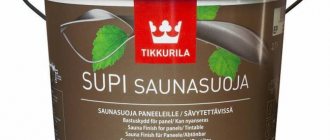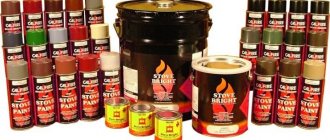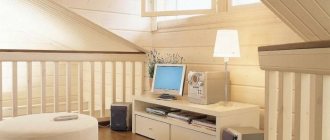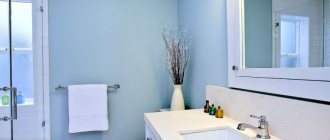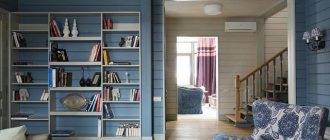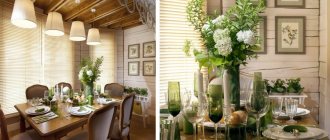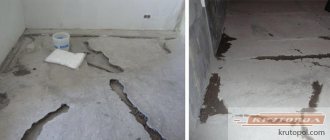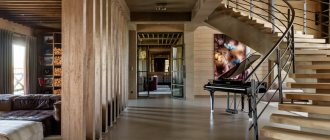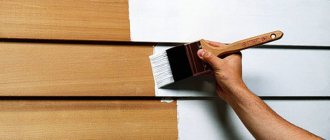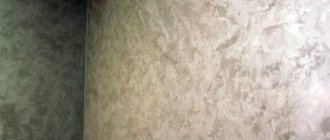Construction markets are replete with materials for interior and exterior decoration. Despite this, wood is perhaps the most popular type. Recently, there has been a renewed trend towards decorating the interior walls of apartments with wood. Thanks to its texture and pattern, it gives the room a feeling of comfort, reliability and warmth; designers use it to add originality and expressiveness to the interior. A large selection of species and structure makes it difficult to choose the necessary material for a particular room. The lining is painted in order to increase its service life, since varnishing protects the wood from the harmful effects of direct sunlight, moisture and wind. The most popular is pine lining. Below are instructions on how to properly paint varnished lining without losing its aesthetics.
Varnished surface
Wood varnishes have a wide range of possible options. This is a dense and thick material that is applied to the coating in two layers after previous drying. The advantage of painting is that the varnish also acts as a protective layer for the facing coating against moisture, dampness and fungus.
Varnish coating of lining
Using varnish allows you to slightly change the shade of wood without disturbing its individual pattern. Also, in this way you can make the surface matte or add a glossy shine to it. Varnish is an inexpensive material and requires one to two days to dry. Also, the coloring does not have an unpleasant odor and will last the room for about ten years.
Varnishing
This method is the most popular, as it does not require a lot of time, effort and finances. Alkyd or water-based varnishes reliably protect the coating from external influences, highlight the natural color and pattern of wood, and make the surface vapor-proof.
In addition, modern manufacturers produce products with additives that have bactericidal properties and protect against solar ultraviolet radiation - such compositions will help update the lining on a balcony, veranda or other open area.
Varnishing the walls has one more advantage - the darkened lining will become a unique decorative element when stylizing the room in an antique style.
Paint for lining
To paint the lining, use glazing and coating antiseptics, oil and acrylate paints, acrylic aqualacs and alkyd varnishes.
Oil paints are perfectly absorbed into wood, do not allow moisture to pass through and have excellent resistance to precipitation. But over time, the surface treated with such paint loses color and dullness and dries very slowly. If you painted the lining in a dark or bright color, it will quickly lose its attractiveness.
Acrylate paints are also resistant to precipitation, but unlike oil paints, they retain their color and shine much longer. Surfaces treated with this paint have the ability to breathe, they are vapor-tight, elastic and do not crack.
It is recommended to use acrylic aqualas indoors, as they are environmentally friendly and do not cause allergic reactions.
Alkyd varnishes are usually used to cover floors because they are hard. The service life of such varnishes is no more than 10 years, then it is necessary to repeat the painting of the lining.
Painting lining indoors
Before you start painting the lining inside the house, you should stock up on the necessary tools. For this we will need: a painting tray, a bucket, varnish, paint, a brush, a roller, a spray gun, a ladder, pumice, primer, safety glasses.
We paint the lining inside the house in stages.
- First you need to clean the surface of dirt, dust and old composition. If this is not done, the paint will peel off and you will have to start all over again. If the surface is heavily contaminated and the old rags stick firmly, then for removal you can prepare a solution of 300g soda in a bucket of hot water. In order for the paint to adhere strongly to the surface, it must be degreased with an alkaline washing solution.
- Then we grind the surface, for this we use ordinary pumice.
- Now we apply a primer antiseptic, you don’t have to do this, but to enhance the effect and durability it is better to apply it. The fact is that wood releases resin over time and thereby reduces the protective properties of the paint.
- The last stage is painting the lining. You can cover it with paint or a transparent antiseptic, and use a roller, brush or spray gun for application. The final painting of the lining inside the house is applied in a thin layer, from top to bottom.
Painting is carried out in three passes. The first thin layer is applied, dries, the second thin layer is applied, and after drying, a third layer can be applied if necessary. It should be remembered that applying several thin layers will be more effective than one thick layer. Another little tip, so that the brushes are not visible, the last layer should be applied from top to bottom.
How is coloring done?
How to paint lining so that the effect is long and impressive? For such an event you will need a set of tools:
- Set of brushes and roller. If possible, then a spray gun.
- Tray. To make it easier to pick up paint.
- Protective and decorative compounds.
- Sandpaper, stiff brush.
- It is better to have a stable stepladder and glasses to protect your eyes.
Using a spray gun allows you to quickly complete the work of painting the lining.
Painting consists of several stages. It is much more difficult when work is carried out on an old coating. Then it becomes necessary to remove the old decorative layer and clean the surface well.
Stage one - preparation
Purchased products are checked for possible damage and deformation. It often happens that materials are purchased that belong to a lower class. They require a long preparation - they are processed with sandpaper, and the cracks are covered with wood putty. If there are dark spots on the surface, then bleaching is performed.
If the material has defects in the form of cracks, they are eliminated using putty
Stage two - primer
It is necessary to cover the front side of the lining with priming compounds. This will reduce the consumption of other solutions, increase adhesion, and will also prevent the elements from being subject to deformation
In this case, special attention is paid to the knots; they are literally impregnated to eliminate the possibility of falling out if drying occurs
The primer improves adhesion when painting lining
Stage three - impregnation
Now protective impregnations are applied. These are fire retardants and antiseptics. Impregnation is carried out over the entire surface. Do not allow unpainted areas to remain
It is important to consider that such products should not have any foreign (pungent) odors or change the color of the wood.
When applying protective impregnation, it is necessary to ensure that no untreated areas are left.
Stage four - coloring
How to paint lining inside a house? This procedure begins only after the material has dried well from previous manipulations. The process is:
- The paint is prepared in advance. The solution must be well placed, because at the bottom there may be sediment, which includes the main components.
- A small part of the composition is poured into the tray if a roller is used. It is better to provide a container for the brush that is easy to carry. Using a spray gun makes the work better, and the paint is poured into a special container.
- It should be taken into account that movements are performed along the fibers of the material. You can’t stay in one place, the coating should be uniform.
- Several layers are applied, this will provide an excellent decorative effect.
To obtain a good decorative effect, the paint should be applied in several layers.
Still, how to cover the lining? This question is quite complex, the answer to it depends on many factors that are calculated purely individually. But it must be taken into account that if the composition is used over large areas, then it must ensure the “breathing” of the material.
Advantages and disadvantages of painting lining
Painting the lining with enamel or colorless varnish can extend the life of the material. If the board is used for covering walls and work surfaces in a utility room, you can get by with regular impregnation. In a house or apartment, it is better to paint wood paneling with high-quality paint for practical and decorative purposes. After all, replacing a damaged top layer of wood is much more expensive than several cans of enamel. You can purchase a ready-made painted board or paint it yourself. Coating panels with your own hands has many advantages:
- Possibility of coloring elements in different colors, applying your own design, texture;
- Saving money. Treated lining is much more expensive;
- Possibility to choose the most incredible shade;
- Increasing resistance to negative external factors;
- Quick drying.
There are practically no disadvantages to painting lining. The main negative point is the loss of the natural pattern and appearance of the wood. Some negative consequences can be avoided if you take into account the purpose of the room when choosing a paint and varnish material. Oil impregnation and drying oil are not suitable for baths and saunas. It is better to use solid mixtures with the addition of wax. It is not recommended to use flammable, toxic enamels for painting wooden boards in closed, unventilated areas. Painting lining floors should be carried out taking into account the abrasion of the material. To avoid having to repaint frequently, you should choose mixtures with high wear resistance.
Solutions used for coloring
There are many means for covering lining. These are compositions for internal and external cladding of premises. They differ in composition, speed and quality characteristics. For example, a wooden exterior façade is affected by ultraviolet rays, moisture, high and low temperatures, so the finishing coating should contain the predominant majority of protective components.
You can decorate the lining of the interior of the house with ordinary enamels and paints. Painted natural boards have an original appearance. Each mixture after painting gives a certain effect to standard lining. The choice of solution depends on the preferences of the owner of a country or city building.
Color palette
The choice of color when painting lining is determined by the style of the interior, its color scheme, as well as the taste of the owners of the house.
Not everyone likes a light and smooth surface. Some people will want to add brightness to the interior, while others, on the contrary, will want to shade it with dark splashes. Some will emphasize the structure of natural wood, while others will decide to hide it completely. All this is a matter of taste.
Often when painting lining, white is used. Whitewashed wood, especially oak, creates a special atmosphere in the house. Light shades visually expand the space, “lift” it, add air and spaciousness. Therefore, rooms with a small area are most often decorated in light colors.
Combined with the structure of the wood, the effect is truly magnificent. Such a surface will fit into any style; it will harmonize with almost any environment and color. Translucent paint that does not hide, but emphasizes the wooden texture and gives a white tint to the material itself is a good option for slightly refreshing and updating the interior without drastic changes.
To create a bright color accent, you can use acrylic or oil paints. They offer a fairly wide selection of shades - from discreet muted to flashy bright ones.
Another option for adding color to the lining is the use of tints. They can be added to water-based paint, glaze, and obtain a variety of shades of any degree of saturation. By properly mixing several tones, you can get a rather interesting complex shade that will fit perfectly into a given interior. But in order not to spoil all the base paint (to which the colors will be added), it is better to pour a little into a separate container and try there.
In general, painted lining itself creates an interesting effect in the interior, especially when the structure of the wood remains clearly visible. It is not for nothing that such a solution is increasingly found in a variety of designs, in different colors and in different styles.
What kind of varnishes are there?
The huge selection of paint and varnish products is confusing. Today, varnishes for covering lining are:
- acrylic water-based;
- alkyd;
- water-based;
- acrylic-polyurethane;
- polyurethane.
Acrylic water-based ones are chosen for interior work; according to their structure, they are divided into matte and glossy. Alkyd is suitable for all types of work: internal and external. Water-based ones are good for interior decoration. Acrylic-polyurethane is practically not subject to fading and is suitable for sunny rooms. Polyurethane varnishes protect wood from yellowing and UV rays.
Lining painting technology
Correctly paint the lining before installation - then you get a uniform surface without gaps or bleeds. First, they inspect all the boards, sort them, removing all defective ones. Suitable for installation, cut and grind the front part. Use a grinder or a block with 250-280 grit sandpaper attached. Tenons and grooves also pass through; the back of the lining does not need to be treated for painting.
Sander
Dry cladding can be left without impregnation if it is intended for heated rooms. If the material is for a balcony, bathhouse, kitchen, then first thoroughly impregnate the surfaces, sides and ends, preferably twice.
To apply the paint composition use a brush or roller. The paint is applied pointwise along the board, then rubbed until smooth.
When the lining dries, you may have to sand it again - depending on the type of wood. There are those in which pile rises after painting; it is removed. Apply a layer of paintwork again and dry. The lining painted using this technology after assembly looks the same from any point.
Sometimes you have to paint indoor lining that is already mounted on the surface. The quality is average, because unpainted areas remain and the surface is difficult to sand. This option is justified if you have to renew old paint. In other cases, the rule applies: first paint, then install.
Some useful tips
If we are talking about painting the lining inside the house, then it would be useful to read some useful tips that will definitely help during the work.
In order to ensure uniform distribution of color on the surface of the lining, it is necessary to thoroughly mix the paint before work. This can be done using a metal rod or a wooden stick. The main thing is that the material is clean.
In order to be sure that the paint is really chosen correctly, before starting work it is worth making a preliminary touch on the surface. Only after this can the main body of work begin.
The most convenient way to apply paint to the lining is with a brush; this will help paint the surface more evenly.
It is best to paint the lining not with a spray gun or roller, but with an ordinary brush. At the same time, apply paint to the surface evenly.
The primer should be the same color as the paintwork. You can make it this way by adding a bit of paint to it before priming.
If the room is too hot, painting is not recommended. In this case, the paint will dry too quickly. This cannot be allowed. It will not adhere too well to the surface of the wood. When it comes to painting, it is better to create optimal conditions for this process. The room temperature should be between 20 and 25°C.
You need to carefully approach the processing of the ends of the lining. To do this, it is necessary to apply a primer on them in several layers, and also apply a paint coating in several layers.
If there is a lot of paint left on the edges of the can, it needs to be collected using a scraper. If it is not there, then you can use an ordinary sheet of iron folded in half.
The paint must be applied with a brush in several layers. The layers should be thin. It is best if there are three layers on the surface. In this case, the lining will be well saturated with paints and varnishes.
Painting wood while maintaining texture
Coloring to more clearly highlight the texture, also called brushing, is carried out with varnishes, oils, resins, and wax. They lie tightly on the surface, almost painting over the fibers, but the large pattern is clearly visible. Special preparations are added to paintwork materials to protect the tree and get rid of existing problems. Modern texture paints include:
- antiseptic additives;
- light-protective from UV rays;
- waxes and oils.
Together they give the coloring agent waterproof properties, biological protection, and protect against fading in the sun. A special property of coating materials used for surface texture treatment is thixotropy. Thick paint, when applied with a brush, liquefies, penetrating deeply into all pores, then becomes viscous again. The layer is easy to level and no smudges form.
Pokarska tree
Painting technology: paint is applied and rubbed. After 10 minutes, when it is absorbed, remove excess oil with a soft, lint-free cloth. The pattern appears more clearly due to the fact that the pigment remains in the grooves and is removed from the elevated part.
In addition to paints, traditional stains are used. Aqueous solutions shade different types of trees; you just need to choose the appropriate color. Be sure to varnish or wax to remove the dull tint. Waterless stains can be used as a base coat.
For texturing, colorless varnish is also used, which at the same time creates reliable protection.
Among natural materials, wax deserves attention, in particular carnauba mastic. The coating is hard and protects well from scratches. It contains various oils and rosin.
How to properly prepare wood
Before applying paint and varnish composition to wood, it must be prepared.
Drying the panel
On raw wood, the maximum service life of paint and varnish coatings rarely exceeds 2 years, and more often it is even less than 1 year. Therefore, the lamellas must be kept outdoors or indoors, the humidity of which is more than 15% for up to 30-40 days. It is advisable to avoid direct sunlight, which will lead to uneven drying.
Deep penetration antiseptics significantly speed up drying.
You can check the humidity level like this:
- cut a square of 0.4x0.4 m from polyethylene;
- wrap the panel and secure it tightly with tape;
- maintain in this state for a day in room conditions;
- measure the moisture content of polyethylene from the inside.
An oilcloth that is wet to the touch indicates that the panels have not dried sufficiently.
Processing of lamellas
If materials are category B, then they must be sanded. To do this, use a power tool or regular wood sandpaper. In this case, the last stage should be carried out with finishing fine-grained sandpaper. This is done to level the surface of the lining in the area of knots, various inclusions, and differences.
Tip You can process the wood after attaching it to the wall with a sander or an abrasive nylon brush.
here
Applying primer
The essence of treatment with this composition is the creation of a dense layer on the surface of the wood, which binds dust, eliminates small specks after sanding, and reduces the porosity of the material. Adhesion increases, and paints and varnishes gain stronger adhesion.
An additional advantage will be the fact that after such surface treatment, paint consumption is significantly reduced. Therefore, you can purchase more expensive and high-quality compounds.
The following types of wood primers are used:
- based on epoxy resin;
- based on silicone and acrylic;
- acrylic.
You only need to choose a special composition for interior decoration; for this you need to make sure that the packaging has the appropriate markings.
Preparation
In order for the paint to be applied in an even layer, you need to properly prepare the wood. At this stage, the lining is cleaned and polished.
Cleaning involves removing contaminants from the surface of the lining.
To effectively get rid of dirt, use a soda solution at the rate of 150 grams of the specified substance per 5 liters of slightly heated water. If there are peelings and cracks on the base, or remnants of old paint, then you need to remove the top layer. For this, a construction and metal spatula is used.
Ideas
In a modern interior it is very difficult to find a place for classic lining with a light fiber texture. Most often it will look like a tree trunk torn out of the forest and brought straight into the house. You need to choose a finishing method and create the desired decorative effect so that the interior looks as harmonious as possible (read more about where lining is used and how to sheathe walls inside and outside with it, and find out how to beautifully sheathe walls and ceilings with wooden boards in a separate material).
There are several interesting ideas for painting wooden panels:
- Alternate combination of different tones of coloring compositions, panels of various thicknesses and widths.
- Multi-profile panels can be combined into an interesting relief.
- The placement of spotlights in different areas of the cladding creates incredible lighting effects that significantly transform the appearance of the lining.
- The use of several colors of paints or varnishes in the same color range, but different in saturation and tone. This will allow you to emphasize some areas and zoning the space.
- Painting on a wooden surface looks very original and natural.
- Bleached canvases create a feeling of spaciousness and a more noble interior.
Important It is important not to overdo it, not to turn the room into a color blot. It is necessary to adhere to a harmonious combination of colors and their saturation.
Material selection
Let's start with one of the stumbling blocks in the debate about painting wood: is a primer necessary?
The answer can be given quite unequivocally: it is not necessary. On the porous surface of wood, any paint or varnish adheres perfectly without primer. The primer will only reduce the consumption of paint and varnish material when applying the first layer.
What about the choice of the actual paint material?
Thoughtful reading of thematic forums will bring us a whole bunch of recommendations based on personal experience.
- Drying oil . Traditional coating will be an inexpensive and effective way to protect the tree. You need to dry the lining at least twice, with each layer completely dry. Unfortunately, you will have to keep the windows open while drying. Drying oil smells, and quite strongly.
Different rooms one approach
Correctly selected colors look harmonious in the interior
Warm colors include light tones and shades of light beige, yellow and light brown.
So:
- How to paint the lining in the kitchen, and what color, keep it in one color or combine it with several shades. In the kitchen, selections in the form of panels are common, in which the lower part is decorated with a darker shade and the top with a light shade. Painting tape with small brushes, multi-colored paints and the imagination of the owners turns boring work into an interesting, creative process.
- If plastic products are chosen for the internal lining, then the problem of painting the plastic lining or not should not be considered. Plastic lining is available in a rich range of colors, with a perfectly smooth surface, so there is no need to fence your garden.
- Apartment owners often turn the balcony into a living space, insulating and covering the surface with clapboard. Country housing is expanding its borders, and these are arranged gazebos, verandas, and appropriate finishing is needed everywhere.
- If you don’t want to think about how to paint the lining on the veranda or inside the balcony, you can contact a specialized store. Employees will perform all operations such as antiseptic treatment, UV glazing and even varnishing. All that remains is to use it for its intended purpose on the balcony, veranda, because the varnish will not allow moisture to be absorbed into the wood.
- It is much easier to cope with internal tasks, but there is also lining outside buildings, what to do with it?
- Processing the lining on the outside is not very different from working on the inside, and the preparatory work is very similar.
- The surface of the facade is cleaned of dust and dirt. Decorative elements from the platbands and shutters are removed.
- Heavily contaminated areas are treated with special compounds against various harmful microorganisms.
- Cracks, seams, joints are sealed.
- The lining is carefully processed and dried.
The surfaces are on different sides of the building, but the approach to painting is the same and pursues specific goals. Wood must be protected from precipitation and become resistant to high humidity.
The lining should not fade or crack, rot or mold. After painting, the tree is not affected by wood borers, insects, bark beetles, and receives UV protection.
If all these signs are present, then we can assume that the final positive result has been obtained.
Shine of paint or transparency of varnish
Masking minor wood defects with paint
When choosing paint for lining, it is important to understand that pre-treatment of products against high humidity, fungi, fire and microorganisms must be carried out with compounds on which paint and varnish can be applied. Paint can be divided into 3 main types: glossy, matte and specially designed for wood, that is, “breathable”
So:
Paint for lining is available in several types. Alkyd enamels related to universal compositions. Any base is suitable for them, and the price on average is close to 100 rubles/kg. When using these enamels on the surface, a smooth, dense coating is obtained that does not delaminate during use. Water-based acrylic emulsion paints do not hide the structure of wood under a thin layer, do not shine, and are used for work inside the house. A beautiful clapboard door is obtained after painting it with oil paint. These compositions are deep penetration agents; they help increase the resistance of products to adverse external factors, and are therefore recommended for external use. The only thing you can’t ignore is the long wait for the paint to dry and the decrease in color intensity with prolonged use, but after a long period of use, right? There are often cases when the surface of the lining has darkened, turned blue on poorly dried boards, or traces of fungi have appeared, then you will have to remove this yourself and bleach the boards. A two-component composition based on active oxygen is used. It does not destroy the top layer and removes fungus while simultaneously brightening the wood
There is also a product based on active chlorine, but it consists of 2 parts and the treatment is carried out one by one. We’ve mostly decided on paints, but what are varnishes and, for example, how to paint varnished paneling so that the paint lasts a long time? Experts advise paying attention to the individual qualities of the compositions. There is no doubt that the positive properties of varnishes can be divided into a separate group:
- They provide protection from the environment, be it favorable or not so favorable.
- They stay on the surface for a long time without visible changes.
- They decorate the surface and have a positive effect on the structure of the wood, so painting old lining (see How to paint lining indoors to get the desired result) gets a new face and its service life is extended.
- Varnishes dry quickly and level, which allows you to get a surface close to perfectly smooth.
- The varnishes contain components that do not allow wood to ignite quickly.
- Water-based varnish is divided into one or two component. Where there is only one component in the composition, it means that it does not contain a hardener, it is easier to work with, but it does not last long.
- The 2-component type contains a hardener, and it more effectively protects the wood for a long time, preventing it from swelling and crumbling.
- Acrylic water-based, acrylic-polyurethane, alkyd - here is a small list of varnishes from which you can choose the one you need.
Choosing the right paint is the key to success
The most popular are the following substances.
Acrylic. Manufactured on the basis of acrylic resins. They are known as a durable material, without a strong odor, easy to use, and have excellent covering ability. Huge selection of paints by color and properties.
Vinyl. They give the surface a special, pleasant matte color and are easy to use. Disadvantages: quick contamination (and equally quick rinsing), poor water vapor transmission capacity. A hybrid of the two previous types - acrylic-vinyl. They have absorbed their properties.
Latex. They are distinguished by great strength, quite resistant to direct sunlight and washing off. Covering properties are also excellent. They dry quickly enough and have a characteristic smell.
Acrylic-latex. A very good choice for painting walls in corridors, staircases and entrances. Specially developed formula for walls with increased dirt and damage. Ideal for rooms with high humidity. This paint combines strength and elasticity, and the ability not to absorb moisture.
In addition to all of the above, mineral paints are used, which are water-dispersion emulsions of the following types.
Limestone, which are created on the basis of slaked lime. They have a budget price, but the dirt on such a wall will not be washed off.
Silicate - using liquid potassium glass, which reacts with lime. The result is a durable, vapor-permeable coating that is easy to clean. Most often used for painting facades.
Cement ones provide a durable coating, however, the color is quite unstable.
Enamel paints are a separate subspecies that are used primarily when working with wood, but can also be used when painting panels and streaks (they have the properties of hiding stains). Below are the main types of enamel paints.
Oil or chlorinated rubber. They are characterized by durability, low wear and excellent washability. They can be matte, semi-matte, shiny.
Acrylic. They fit inside the wood structure quite firmly and are resistant to abrasion. They can be used on the same surfaces as oil and chlorinated rubber, but give the walls the opportunity to “breathe”.
Adhesive paints that have a connecting link in the form of plant, animal or synthetic glue have acquired new properties.
A new type of product on the market - methylcellulose colors are widespread due to their properties of giving surfaces a unique texture. They are sold in the form of a dry powder, which must be mixed with other liquid substances to work. Apply only with a special device. The coating itself is durable, but cannot be washed.
Structural. They are in great demand. They have a dense density and are very plastic, thanks to these properties they give wooden surfaces a rather interesting effect. There are a great variety of application techniques: both construction tools (spatulas, rollers, tampons) and improvised means (scrubbers, rags, etc.) are used. A wide range of colors, various pigments, moisture impregnation - all this makes it possible to fully demonstrate your decorative abilities and give the room a unique effect.
Before considering the question of how to repaint lining that has already been varnished, it is necessary to study the selection of varnishes that are presented on the construction market and choose the one that matches the design idea and the physical characteristics of the wood.
Coating options for lining
Impregnations with a specific function
Modern sellers of paints and varnishes are ready to offer their customers a large selection of different impregnation options. These compositions differ from each other, depending on the purpose for which they are intended.
Pinotex Ultra will create comprehensive protection for wooden panels
- Use of fire retardants. These substances can significantly reduce the level of fire hazard of the processed material. Accordingly, treatment with a fire retardant compound is a prerequisite for extending the life of the lining, as well as for ensuring safety.
Compositions against bacteria. With the help of such impregnations, you can protect the lining from various types of rotting, contamination, as well as from damage by fungi and bacteria.
It is worth noting that for the treatment of internal walls, coatings with a special mark are required. This will allow you to choose a harmless option that is water-based;
Water-based acrylic varnishes
Their use is suitable for finishing lining when it comes to covering the inside of a house. Using acrylic you can achieve not only a purely aesthetic effect, but also protect wooden panels from external influences.
Apply acrylic varnish in two steps:
- Step 1 – applying a transparent base, which is a must if you are looking for how and what is the best way to paint the lining inside the house;
- Step 2 – direct addition of color, this is possible if you use a special tinting mixture. Here you can choose absolutely any shade, depending on your preferences.
Coating the lining with a layer of tinting mixture
- Synthetic based varnishes. They are more toxic than acrylic varnishes, which are based on water. However, using synthetics you can achieve the smoothest surface and shine, since they contain certain substances. Among them are toluene and xylene. The presence of these substances in impregnations of this type allows them to be used exclusively for external work, due to their too high toxicity and harmfulness to the residents of the house;
- Wax compounds. These materials for covering lining are an excellent replacement for varnish. With their help, they provide not only their characteristic semi-matte shine, but also excellent protection for wooden panels. However, it will be difficult for a non-professional to apply this composition; it is advisable that only an experienced technician do this.
Coatings for decorative function
The compositions for coating wooden panels indicated in the previous paragraph have one common undeniable function - they serve, first of all, to extend the service life of the material and protect it from any influences.
In the event that your first priority is to decorate the room by finishing it with clapboard or changing an existing design, then you will have to figure out what is the best way to paint the clapboard inside the house again.
Paint for lining with decorative function
Among the various compositions for decorative processing of wood panels there are:
- Oil paints. They are distinguished by excellent resistance to all external influences, even when it comes to moisture. In addition, the paint penetrates perfectly into the wood structure, but dries very slowly. Most oil paints tend to lose color over time after application, resulting in the need for constant renewal;
- Acrylic based paints. This option is much better than a simple oil one, since it will preserve the color much longer, while maintaining the shine. They are not afraid of temperature fluctuations, as they are characterized by increased elasticity. However, this type of paint has a certain drawback - the price.
It is this that causes the frequent choice of many home owners in favor of simple oil coatings;
Aqualak paint
Aqualak. This is acrylic based paint. It allows you to achieve excellent results in painting lining, when it comes to painting indoors. Moreover, coatings of this type are non-toxic and do not cause allergies.
The lining under the scuba tank is shown in the photo
To summarize, it can be noted that there are plenty of paints that perform the decorative and protective function of wooden panels. However, you should approach your choice very carefully, having studied all the markings and features of the compositions.
It is advisable that you first read the instructions provided by the manufacturer. It will be indicated there where and how this coating should be used, under what conditions it can retain its properties and how long its effect lasts.
Impregnations
These compositions are distinguished by the fact that they penetrate deep into the structure of the material and do not create a film on the surface. Some of the solutions discussed below can be used as a full-fledged protective layer, others can only be used as preparation for finishing.
The most popular options are:
- Stains give the surface a certain shade, but do not protect it from water and other influences. The compositions can be water-based, alcohol-based or oil-based. They differ in properties, but perform the same function. The choice depends on the specific conditions, but the most popular are water-based solutions; they are distinguished by their low price and safety;
Before covering the lining with stain, you should choose the desired color
- Acrylic-based impregnations are often called glazes. They differ from stains in that they tightly close the pores of the wood, so they can also be used as a finishing finish. If you are thinking about how to cover the lining to prevent it from darkening, then this option will come in handy. Acrylic emulsion reliably protects against ultraviolet radiation, and the surface retains its original color for a long time;
If you are thinking about how to cover the lining outside the house, then choose acrylic compounds with wax, they are especially reliable
- How to cover the lining outside the house or inside the premises to protect them from mold? Antiseptic compounds provide excellent protection against fungus and extend the life of wood significantly. Such solutions are used exclusively as a preparatory layer; the surface is always covered with something again;
Antiseptic impregnations can tint wood to the desired color
- If you are thinking about the best way to coat eurolining in order to increase its resistance to fire, then the best option would be special fire retardant compounds. They also serve as a preparatory layer before the main coat. A universal fire-bioprotective solution can be an excellent solution; it makes the material resistant to both fire and mold.
Universal formulations are very popular
Choose products from well-known manufacturers. You won’t be able to check its quality by eye, so it’s better to consult to find out which formulations have proven themselves best.
This group of products allows you to create a durable layer on wood that protects the material from moisture. In addition, using varnish you can give the surface the desired shade, or you can use colorless options.
Let's figure out what types of compositions there are:
- Oil-based solutions create a durable protective layer that has good abrasion resistance. They can be used to treat any indoor surface. This option is characterized by low cost and a fairly large assortment of colors;
Oil compositions give the lining a rich color
- If you are thinking about how to cover the lining on the loggia, then pay attention to alkyd varnishes. They adhere very well to the material, give it shine and an even structure and protect it well from moisture;
How to paint lining inside a house: ideas
Painting techniques and methods are great, but how to fit lining into a modern interior? Just. There are many interesting options. The designers' latest finds are a clapboard wall in a room with smooth walls. It looks creative and interesting. And most often such a wall is made using the brushing technique.
One of the options for using lining in the bedroom interior
An interesting effect is achieved by combining fittings of different thicknesses - in the photo, thin ones are inserted between wide boards. Moreover, they are painted in different shades of the same color. The combination turns out interesting and fresh.
Lining is also used to create interiors in a modern style.
Lining is not necessarily just a flat board with small grooves on one side, which is also called eurolining. There are different profiles, including those with waves and troughs. From them you can assemble interesting walls, the relief of which is emphasized by painting.
You can assemble interesting reliefs from linings of different profiles. To make it look more interesting, highlight the reliefs or whiten them
As usual, in the interior, a lot depends on the light. Several non-standardly designed lamps - long translucent strips behind which lamps are hidden, installed in the middle of the ceiling - and the interior is completely transformed. This design can be used to decorate rooms for young people, creative living rooms, etc.
Very interesting solution with lighting
You can play not only with light, but also with color: in the lighting zone, paint the lining in a lighter color, thus emphasizing this zone.
Play of light and color reflected in the mirror
If you have good drawing skills, you can paint the lining. Just don’t forget to then cover the entire painting with colorless oil or varnish to preserve it longer. This technique can be used when decorating a children's room.
Painting on lining
Rigidly defined lining panels look great in the interior of an office, living room, or hallway. In the same vein, you can decorate the wall in the dining area in the kitchen. Only its quality and coloring must be perfect.
The honey shade of the lining is repeated on the ceiling
Treatment for a rustic-style interior can be deliberately imperfect. These are rooms with a masculine character.
The rustic style will appeal to men. In this case, painting the lining using the brushing technique is the norm. Moreover, the colors are chosen dark
As if in contrast - light walls. The lining is whitewashed and the beams are painted dark. Despite the traditional materials used for centuries, the look of such a room is modern and stylish.
An excellent combination is light walls with the effect of bleached oak and dark massive beams. It's practically a win-win option.
Variation on the same theme
Lining is also used in the decoration of bathrooms. Impregnation here needs to be given maximum attention, but if the ventilation in the bathroom is at the level and the impregnation is protected from moisture, then there should be no problems. And the interior, you see, is very interesting - warm wood tones combined with bright marble are a great move.
Lining in the bathroom
Lining is also used for finishing balconies. You just need to fill it horizontally - this way you can expand the small space. And light colors look better in such a small area, maybe with a dark edging.
Whitewashed paneling on the balcony
Ceiling - lining, painted with light stain
About the need to process the lining
Many people sincerely believe that walls covered with wood panels are beautiful in their natural appearance and do not require additional processing. Knowledgeable people have several reasonable objections to this; they indicate the need to protect sheathed walls from the following factors:
- Actions of ultraviolet radiation . If a wall covered with clapboard is regularly exposed to sunlight, over time the wood will darken and the walls in the room will begin to look different.
- Color changes . If the ventilation system in the house is poor, the air begins to stagnate. In places of high humidity, microorganisms develop and wooden lining may turn blue.
- Damage to the structure . In a room with excess humidity, wood easily harbors pests and mold; this causes rotting and destruction of the finishing layer.
- Mechanical damage . A layer of paint and varnish will absorb scratches and impacts and will not spoil the beauty of the walls.
- From fire . It is considered reasonable and prudent to protect wooden surfaces from the rapid spread of flame.
Unprotected lining is an easy target for destructive factors. Source drewinwest.com
Sometimes owners think about changing the interior. Lining can be easily updated - there are dozens of coating options and hundreds of shades that make it possible to make familiar rooms unrecognizable.
There is no clear answer to the question of how to paint wooden panels inside a country house. The choice is determined by the goals - whether the owners only want to protect wooden walls, refresh tarnished surfaces or radically change the color. Materials suitable for processing lining can be divided into two types: protective and decorative.
Carrying out the procedure
To paint wooden panels, paint or varnish with colors and dyes of different types and compositions is used (how to properly varnish a panel for a long time?). Application techniques and finishing methods depend on the composition of the paintwork material.
Varnish
To paint wooden panels with varnish you will need:
- check all existing lining, sort it by color and quality, exclude panels that contain falling knots or other obvious defects;
- thorough sanding is carried out until absolutely smooth to the touch is achieved;
- if necessary, cover with a special primer or apply the first base layer of varnish, leave each canvas to dry without touching the treated surface;
- if an opaque varnish is used, then repeated sanding over the painted layer is necessary;
- A second layer of varnish is applied until the color is uniform over the entire area of the canvas, and then dried.
Tip Rejected panels can be used as test panels. On them you can see the type of coating with different numbers of layers, etc.
You can watch how to properly varnish the lining, what tools and techniques to use for this, in the following video:
Dyeing white
To create the desired decorative effect, several coloring techniques are available:
- Acrylic pigment primer diluted to 80-100% is applied like a regular varnish. It creates a coating with a long service life, but its price is high.
- Polyurethane pigment primer labeled “bleached” or “white” with a dilution of up to 80-100% also provides the desired decorative effect, but over time the color becomes yellow.
- Oil with wax - with a single-layer coating requires rubbing with a rag to preserve the wood texture; with a two-layer finish the surface is opaque.
- Tinting or staining - often found with the markings “bleached oak”, “frost” and the like. The peculiarity of the finishing is a multi-layer coating with very thin and uniform films. Otherwise, a peeling effect will form on the surface.
These methods provide different shades of white, depending most on the type of wood.
You can learn how to quickly and correctly paint the lining white from this video:
Applying varnish
Coating lining with varnish begins with reading the instructions for a specific product. It indicates the recommended conditions of the room in which finishing work is planned to be carried out. A primer layer is first applied. You can use a roller for this, but it is important to fill all the unevenness of the lining. The primer usually takes several hours to dry, depending on the specific brand and manufacturer, and then the wood is treated with an antiseptic. This improves the durability of the surface. After the antiseptic has dried, begin to cover the lining with the composition. Pre-stir it until smooth to prevent the formation of streaks on the surface of the wood. Apply the composition with a tightly packed brush; it is advisable to make the layer not too thick so that it can dry evenly. After the first drying, the varnish layer must be sanded to remove the gloss, and a second final layer must be applied, which should be glossy or matte. Keep in mind that the solution must dry completely before the second application, otherwise there is a possibility of inadequate drying of the coating, which can ultimately lead to the formation of streaks and uneven layers.

